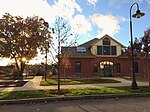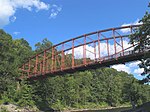Burkeville Covered Bridge
1870 establishments in MassachusettsBridges in Franklin County, MassachusettsConway, MassachusettsCovered bridges on the National Register of Historic Places in MassachusettsNational Register of Historic Places in Franklin County, Massachusetts ... and 3 more
Road bridges on the National Register of Historic Places in MassachusettsTourist attractions in Franklin County, MassachusettsWooden bridges in Massachusetts

The Burkeville Covered Bridge is a historic covered bridge, carrying Main Poland Road over the South River in Conway, Massachusetts. Probably built in 1870, it is a regionally rare example of a multiple kingrod bridge with iron tensioning verticals (a modified Howe truss system), and one of a few 19th century covered bridges to survive in Massachusetts. It was listed on the National Register of Historic Places in 1988.
Excerpt from the Wikipedia article Burkeville Covered Bridge (License: CC BY-SA 3.0, Authors, Images).Burkeville Covered Bridge
Main Poland Road,
Geographical coordinates (GPS) Address External links Nearby Places Show on map
Geographical coordinates (GPS)
| Latitude | Longitude |
|---|---|
| N 42.507777777778 ° | E -72.711111111111 ° |
Address
Burkeville Covered Bridge
Main Poland Road
01341
Massachusetts, United States
Open on Google Maps









